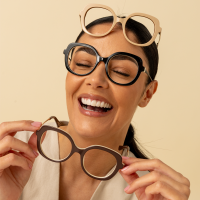Grey and teal, or is it pink and white?
This image has been buzzing around social media for a while now, keeping colleagues arguing, families fighting, and generally generating quite a buzz on both Facebook and Twitter. And yet there has been no convincing reason put forward as to why people fall very distinctly into either the pink-n-white camp or the grey-n-green one (much like #thedress from 2012!).
There is no right or wrong answer. (Well, actually there is, but let’s wait till later to discuss that.)
We decided to set about trying to figure out the reasons. We asked a fine artist for her professional opinion. Then to balance things, a cognitive researcher was called upon to put forward a more scientific explanation for this optical illusion. Lastly, we asked one of our esteemed Torga optometrists, Elani Van Der Westhuizen, for her two cents. Here’s what they all said:
Fine artist, Sally Rumball, who expressively uses colour in all her paintings, was intrigued and offered us this explanation:
“To me, it’s about colour relationships. If you replace the background with black, the shoes (which were grey and teal to me at first) turn pink and white. I cannot explain it in terms of science, but I feel it has something to do with the relationship that one has with different colours and the placement of different colours together. (Please tell me what the science people say! ;-)”
A researcher in cognitive science, Jon Mirkel said: “It is as if there is a perceptual equivalent of those who can roll their tongues and those who can’t. But I think that it is too early to say whether the difference is genetic, as with tongue rolling ability, or something affected by learning and personality. One’s particular sensitivity to context in perception could also have a bearing.”
Mirkel explains how context may play a part in this case: "Many people may be unconsciously factoring into their cognitive processes the fact that shoelaces are usually white, and therefore see them as white, automatically filtering other hues. Others might be taking visual cues and associations from the tones and colours of other objects in the image, such as the hand holding the shoe, for example."
Elani Van Der Westhuizen, one of Torga Optical’s professional optometrists, begins her explanation with a straight-forward question: what is colour? “In order to see colour, we need an object, an observer and light. Pure white light (colourless light) contains all colours in the visible spectrum. When light hits an object some of these colours are absorbed and only the reflected colours are then visible to the eye. Your brain figures out what colour light is bouncing off the object by subtracting that colour from the real colour of the object,” explains Elani.
All colours have different wavelengths. These colour wavelengths hit the retina in the back of the eye (the cone cells, specifically) where the pigments transmit signals to the part of the brain that processes these signals into an image and colour.
According to Elani, human beings are better able to see in daylight. However, daylight changes the colour of everything we see. The human eye will compensate for the chromatic bias of daylight colour. This also includes objects seen under artificial light. An incandescent light bulb looks yellowish and has the tendency to bring out warmer colours in objects. A fluorescent light bulb has bluer light available and will bring out a cooler ‘feel’ to objects. Could this have an effect on how people see the colours of the shoe?
As the debate is surrounding a digital photograph we also need to think of the digital visual aspects. The image in question was taken in low light conditions, either due to low light in the room, or how the camera perceived/recorded the light in the room. This will, as mentioned above, affect how the object reacts, and reflects the visible light, and thus what colour the shoe seems to be.
At the end of the day, what we could be experiencing is just a colour illusion. Colour illusions are images where the object’s surrounding colours trick the eye into incorrectly interpreting the true colour of the object. What’s happening in this image is that your eye is either discounting the grey so that you see pink and white, or discounting the pink so that you see green and grey. But why would your eyes lie to you like this?
To tie in with our artist’s (Ms Rumball’s) point-of-view, the answer could be that most people will see the shoe against a white background as grey and teal. But on a black background, some (the minority) see it as pink and white. Or, is it genetic visual capability combined with preconceptions, as our brainy researcher suggests? One thing is certain, and backed up by Elani (Torga optometrist), is that light plays an important part.
So, what colour is the shoe? Is there a correct answer? Yes, there is.
The trainer is, in fact, pink and white. This particular brand of trainers didn’t ever make a teal and grey version. The majority of people see teal and grey, but they are wrong. Those of us who see pink and white is quite right!
Professional consultation from:
Sally Rumball (BA Visual Arts (UJ))
Jon Mirkel (BHSc (Wits))
Elani Van Der Westhuizen (BOptom (UJ))
Claire Wiggill (BOptom (UJ))












